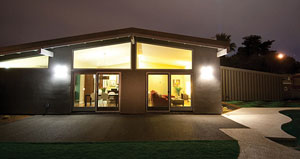Fiberglass Fenestration Comes into its Own
Fiberglass-Framed Windows used in Net-Zero Energy Home |
Building Media, Inc. and Green Builder® Media, LLC, teamed with the U.S. Department of Energy (DOE) and corporate sponsors on a net-zero energy remodel demonstration home for visitors at the 2010 International Builders Show in Las Vegas. Their ReVISION Vegas home is a deep retrofit of a 1963 ranch home that will cut energy bills by at least 60 percent, not counting photovoltaics. The 1,800-square-foot home, a mid-century modern structure with an open, single-story floor plan, low-pitched roofs, post-and-beam construction, vaulted ceilings, and entire walls of windows, was a showpiece in its time, but was sorely missing proper insulation. By 2008, the house had utility bills up to $500 a month. All of the home's single-pane, wood- or aluminum-framed windows were replaced with triple-pane, low-Emissivity, argon-filled, fiberglass-framed windows, which allowed the design team to keep as much of the original window area as possible while dramatically improving energy performance. The total remodel improved the home's energy performance enough to make it a net-zero energy home by the DOE's EnergySmart Home Scale. "The fiberglass windows were an absolutely perfect choice for the ReVISION House Vegas. The product not only satisfied our strict requirements for superior energy performance, structural integrity, stability, and durability in the extreme desert climate, but they also delivered the sustainable materials and manufacturing processes making for an exemplary addition to our project," says Ron Jones, President, Green Builder®. "Additionally, we had to adhere to very high standards of architectural style in order to preserve the look, feel and finish of the classic mid-century modern home we were renovating. The profile and finish proved to be ideal. We simply could not have made a better selection at any price. We are thrilled with the results." The ReVISION Vegas is part of the Green Builder® Media VISION Houseâ„¢ Series. |
 |
Fiberglass frames helped cut energy costs by 60 percent on this remodeled home at the 2010 International Builders Show. Photo: James Kegley |
Cost. One downside of fiberglass windows has been the cost, with prices running 40 percent to 60 percent more than the average vinyl window. A key factor here is the complicated pultrusion process, which is not as fast as the extrusion process used to fabricate vinyl or aluminum frames. However, with fiberglass manufacturers incorporating advancements in pultrusion, die design, fabrication, and assembly, larger quantities of fiberglass are being produced faster, with a corresponding drop in prices. In addition, while upfront costs of a fiberglass window may be higher than other window types, because of their durability, fiberglass windows may be a better value over time.
Design Considerations
In specifying a residential window there are a number of factors architects may want to consider.
Sustainability
Compared to other common window frame materials, fiberglass is considered to have the lowest embodied energy while providing the longest life expectancy. It requires a limited use of resources and low pollution levels are emitted during the manufacturing process-attributes that have led experts to recognize fiberglass windows as a sustainable product.
Fiberglass is made from silica sand, an abundant natural resource that is readily available almost everywhere. The embodied energy used to extract the glass from the sand and the embodied energy used to convert the raw materials into the finished fiberglass pultrusion is less than that of other framing materials such as aluminum or PVC: aluminum requires heating up to 1700 °F while vinyl requires up to 425 °F, and fiberglass, 200 °F or less. The high energy use, and to a lesser extent the emission during production of aluminum-clad wood and vinyl windows, work against them in a sustainability equation.
As a thermally set, inert material, fiberglass is non-polluting and does not out-gas or emit any volatile organic compounds over its entire lifespan. If in a landfill, fiberglass does not leech chemicals into the ground or water. Quality fiberglass frames are composed of at least 60 percent glass.
Another sustainability issue involves life expectancy. Although fiberglass is considered a relatively new material for the fenestration industry without an assessment of long-term performance, the longevity of fiberglass as a material can be seen in the marine industry, where fiberglass boats remain seaworthy after half a century with little degradation.
Energy Efficiency
When it comes to the energy efficiency of a window, glazing is the prime consideration, but other factors also carry weight. Energy efficiency is generally measured by U-Value, used to express the rate of heat loss; the lower the U-Value, the greater a window's insulating properties. According to the Efficient Windows Collaborative, high-performance double-pane windows can have U-Values of 0.30 or lower; some triple-pane windows can achieve U-Values as low as 0.15. Fiberglass is widely considered to have the lowest U-Values of all framing materials, and when filled with insulation can attain U-Values as low as 0.2. True energy efficiency is based on a combination of factors. Considering a triple-glazed window with an insulated fiberglass frame, two low-E coatings, and two gas fills can achieve U-Values as low as 0.13, improving on the energy efficiency of a clear single-pane window by nearly 90 percent, it is worth the effort to investigate the options fully.









